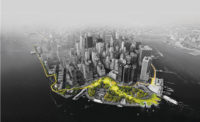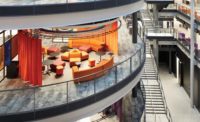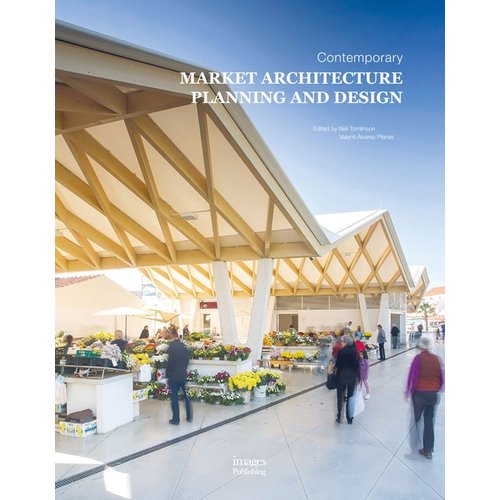Continuing Education: Designing for Extreme Heat
As heat waves intensify, passive cooling strategies for buildings and public space can save lives

Heat is the top weather-related cause of death worldwide. Each year in the U.S., heat stress kills an average of 702 people, according to CDC data, and sends some 68,000 more to emergency rooms. In 2021, hundreds died in a single week when a one-in-a-thousand-year heat event drove temperatures in the Pacific Northwest and British Columbia to unprecedented levels. This year’s early heat wave across much of the South, Midwest, and Southeast inflicted dangerously high temperatures on tens of millions, with the heat index, a measure that takes account of temperature and humidity, soaring as high as 120 degrees Fahrenheit. In response to heat-related suffering, and with climate change predicted to increase heat wave frequency, duration, and intensity, there are calls for building standards to mandate air-conditioning. But air-conditioning alone isn’t going to cut it. This is a job for design.
For one thing, research in the American South and Southwest is finding that most of the homes where heat-related deaths occur already have air-conditioning, but it’s not working—because it’s broken, or because residents are trying to save money on electricity and don’t realize that they’re becoming dangerously hot, or because the power is out, sometimes as a result of too many people using their air conditioners during a heat wave. “It’s paradoxical to imagine air-conditioning ourselves out of heat waves,” says Alexandra Rempel, an associate professor in the Architecture and Environmental Studies programs at the University of Oregon (UO). “As heat waves become more and more intense, is our solution really going to be to add electricity demand, knowing that we will have to meet part of that demand with fossil fuels? Or do we want to see if there are alternatives?”

At its renovated and expanded student residence at the University of Oregon (above and top of page), Mithun is adapting one unit to study the effectiveness of passive-cooling retrofits. Photo © Kevin Scott, click to enlarge.
The primary alternative is passive cooling, which relies on design to reduce heat gain and increase heat loss. To quantify its potential to save lives, a 2022 study conducted by Rempel in collaboration with colleagues at UO, Dartmouth College, Rensselaer Polytechnic Institute, and architects at Mithun used weather files from the 2021 heat event to model conditions in a typical, west-facing, affordable apartment in Portland. Without cooling strategies, the indoor heat index in the model unit climbed off the chart, which maxes out at 124 degrees, and stayed there for 63 percent of the heat event’s duration; for the rest of the time, the heat index remained in the danger zone, over 104 degrees. Against this baseline, the study demonstrated that varied combinations of such low-tech cooling strategies as night ventilation, exterior shades, insulated interior blinds, and ceiling fans could have kept the unit’s heat index below the danger zone for the entire time. “We were really, really surprised at how much we could get the indoor air temperature peaks down within the caution zone or even below,” says Rempel. And, while comfortable temperatures are lower still, says Mike Fowler, a senior associate at Mithun, “the combination of passive measures with a little air-conditioning keeps electrical loads low, energy costs down, and the power on.”

Click drawing to enlarge
One unit at Mithun’s UO student-residence complex is being retrofit with cooling features. Its performance will be compared to a neighboring unit. Image courtesy Mithun
A real-world study is scheduled to start this fall in a UO replacement and expansion residence designed by Mithun in association with Rowell Brokaw Architects. Phase 1 of the complex was completed in 2021, with a subsequent phase nearing completion. Although the buildings, with high-performing envelopes and operable windows, have been designed to achieve LEED Gold and to outperform the Oregon Energy Code by at least 25 percent, they have also been designed to maximize student affordability. This cost consciousness makes them well suited for a study of the impact of developer-friendly passive-cooling retrofits.
For the study, a four-bedroom unit has been modified to include a 4-foot-deep sun space as a buffer zone between south-facing operable windows and the rest of the unit, creating in essence an occupiable double facade. Incorporating thermal mass in its floor, in the form of ceramic tile, and separated from the living room with a sliding glass door, the buffer zone can be opened or closed to the interior or exterior to capture or release heat as required. Cellular shades on tracks prevent window-heated air from circulating into the apartment interior, and a ceiling fan helps to move air at night. Over the coming years, the results of a variety of student-engaged experiments will be compared to conditions in the unit next door, which is identical except for the modifications under study. Because student residences are a useful proxy for affordable-housing units—and with research from the British Columbia Centre for Disease Control identifying poverty as the single greatest risk factor in the 2021 heat-dome deaths—the results of the UO studies have the potential to make a difference in how buildings can help the most vulnerable people cope with extreme heat.
Where the UO-led research has so far focused on operable passive features that are easy to retrofit into a conventional building, the design for North Torrey Pines, a living and learning precinct at the University of California San Diego (UCSD), demonstrates what can be achieved through passive cooling when a building is designed to prioritize it from the outset. Since the impacts of overheating include reduced productivity, compromised sleep, and deteriorating mental and physical health, says Tommy Zakrzewski, principal and director of building engineering physics at HKS, “we wanted to make sure students are able to perform at their best.”

1
At a living and learning precinct at UCSD (1 & 2), HKS has reduced heat gain and promoted heat loss with such features as natural ventilation in community spaces. Photos © Tom Harris

2
The AIA COTE Award–winning project, designed by HKS in association with Safdie Rabines Architects and completed in 2020, optimizes facade design and natural ventilation to meet the ASHRAE 55 standard for adaptive thermal comfort, even in the location’s worst-case future climate. Rather than base the design on historical weather data, which in a changing climate is unreliable, HKS acquired the most recent five years of meteorological data for the project’s location, and then morphed the data using the software tool WeatherShift to generate a site-specific weather file representing future conditions. The climate-calibrated weather file, which UCSD has since adopted as the basis for all its new developments, informed HKS’s iterative shoebox modeling (quick and simple simulations well suited to early design) and the rapid prototype modeling of North Torrey Pines’ building orientation, self-shading, glazing performance, aperture size for ventilation and daylighting, and the corresponding impact on occupant comfort and well-being.
The design took a two-pronged approach to passive cooling. The first focused on insolation (exposure to the sun’s rays), using heat mapping to understand how best to deploy horizontal and vertical shading fins to reduce heat spots and generate thermal equilibrium across the facade. Notably, the analysis showed that reducing insulation levels below those mandated by code allowed for better cooling performance through more rapid night-time release of heat. The second strategy focused on internal gains: controlling equipment and lighting loads, and optimizing natural ventilation for rapid night cooling. Applying standards and best practices defined by the Chartered Institution of Building Services Engineers (CIBSE), all of the building’s community gathering areas, dorm rooms, living areas, and collaboration zones are naturally ventilated.
Post-occupancy visits have verified that window operation, CO2 levels, temperature, and ventilation are working together to achieve thermal-comfort design targets. What Zakrzewski describes as “a breathing building” is achieving air-exchange rates 30 percent higher than code minimums. Regarding effects beyond thermal comfort, even though the building opened at the height of pandemic-related stress and loneliness among students, a longitudinal mental health study found an 8.2 percent reduction in self-reported rates of depression among North Torrey Pines occupants compared to campus-wide pre-pandemic levels. “It shows the measured benefits that designing for a future state can have,” Zakrzewski says.
If designing for indoor survivability and comfort in extreme heat is essential to individual well-being, the design of outdoor spaces is similarly essential to the vitality of communities. A master plan for an urban park in central Tucson (where temperatures now drift well over 100 degrees for sustained stretches of summer) and a public square in downtown Houston (where people are used to avoiding the heat by staying inside air-conditioned tunnels and sky bridges) demonstrates strategies for cooling in the public realm.
Two main drivers, cultural and ecological, shaped Sasaki’s master plan for Tucson’s 131-acre Gene C. Reid Park. “There really isn’t anyone in the Tucson community who can say that they haven’t celebrated a life milestone—birthday, graduation, or family reunion—in Reid Park,” says Alex Hill, a senior associate and landscape architect with Sasaki. For the most part, those celebrations, integral to the culture of the community, center on a ramada, or picnic shelter, that is the primary shade structure in the park. “We thought about the types of people, alone or in smaller groups, that might inhabit this space,” says Hill, “and we recognized a need for smaller, more frequent, and more dispersed shade options.”

Click drawing and chart to enlarge
At a Tucson park (above), Sasaki is selecting trees based on factors like how much shade they provide and water requirements (below). Images courtesy Sasaki

Analysis of the distance to shade from the ground’s parking and major program elements resulted in a plan for a canopies, pergolas, and pavilions located never more than a two-minute walk in the sun from one to the next. Capable of accommodating a greater number and variety of gatherings, the new structures will be organized along a central loop trail and a realigned, widened, and naturalized channel, known as Citation Wash, that contributes to the park’s flood control. Shading devices and pavilions will also form entry features at each corner of the park, both to welcome visitors and as “something that the park can offer the city,” says Hill. “When you’re waiting for a bus or going to see a friend three blocks away, shade is an important amenity.”
As for the ecological driver, the master plan aims for resilience through naturalization. Because the park’s significant shade trees are nearly all exotic and ill adapted even to current levels of heat and water stress, the plan sets out a succession strategy for transitioning to native and adaptive trees. For example, an Aleppo pine with a 40-foot canopy guzzles 23,500 gallons of water per year; it could be replaced with two locally adapted velvet mesquites, providing double the shade canopy for less than half the water. Some of the water that is saved on irrigation will be used to create high-impact, cooling microclimates, such as splash pads and misting stations. The master plan also reduces irrigated grass, in an approach Hill calls “turf with a purpose,” so that apart from such areas as an event lawn, ground cover will also be naturalized. The lush, green ideal of northern European landscape traditions requires a rethink in extreme heat- and water-stressed environments, Hill says: “You can achieve the oasis effect without defaulting to a sheep’s meadow.”

Planting mature trees is a key heat mitigation tactic for RIOS in its Lynn Wyatt Square project in Houston. Photo © Ayala Vargas
On a smaller and more intensely urban site, the 1.9-acre Lynn Wyatt Square for the Performing Arts, due to complete in Houston’s downtown theater district this year, generates the oasis effect in hopes of enticing Houstonians into the public realm. “Historically, Houston has had a pretty vacant downtown ground plane, with people using sky bridges and tunnels to avoid the heat,” says Cameron Stewart, an architect and senior project designer at RIOS, designers of the park in collaboration with HarrisonKornberg Architects. “Our goal was to change the attitude about outdoor spaces, and create a place where people want to be.”
As at Reid Park, shade is a major design strategy for transforming the concrete heat island. Built on top of a 60-year-old, below-grade parking garage, the square is essentially an intensive green roof—one with engineered, free-draining soil, resilient to compaction, that has enough depth to support full-grown shade trees. And there’s no waiting around for them to get big; the locally field-grown trees, native post and live oaks, were already 30 years old when they went in. “That comes at a cost, but there’s actually no way of making up for a 30-year-old tree,” says Peter Emerson, a landscape architect and studio director at RIOS. “We knew that, on day one, people needed to feel comfortable there.” In addition to the trees’ instant shade, evapotranspiration contributes significantly to cooling across the site. “Having just this amount of soil and plant material really improves the climate in the space,” Emerson says. “It’s important to treat the surfaces as living whenever possible.”
Feature elements at each of the park’s corners mark fully accessible entrances to the elevated site and offer a cooling welcome. Facing the approach from riverside Buffalo Bayou Park toward downtown and the theater district, a water feature announces the main entrance, with a ramp switchbacking between waterfalls as they step down to street level. A restaurant, with a curving roof form designed to minimize solar gains in summer and maximize them in winter, anchors the southwest corner and offers shaded outdoor seating along its north side. Edging the business district to the southeast, gardens with movable chairs and tables attract daytime office workers. “At each entrance it was critical to have heat mitigation to pull people into the site,” says Emerson, “to convey that this is a different place, a more hospitable place, a more comfortable place.”
As global heating makes America’s temperate places hot and its hot places hotter, public outdoor spaces designed to mitigate extreme heat, like Lynn Wyatt Square and Gene C. Reid Park, and passive cooling strategies, like those being studied and implemented at the University of Oregon and UC San Diego, have an increasingly critical role to play in human comfort and well-being. With or without air-conditioning, they offer effective, affordable options for extending the heat resilience of the built environment, supporting communities, and saving lives.
Continuing Education

To earn one AIA learning unit (LU), including one hour of health, safety, and welfare (HSW) credit, read the article above and “Improving the passive survivability of residential buildings during extreme heat events in the Pacific Northwest.” Applied Energy, September 2022 (Alexandra R. Rempel, Jackson Danis, Alan W. Rempel, Michael Fowler, Sandipan Mishra).
Then complete the quiz. Upon passing the quiz, you will receive a certificate of completion, and your credit will be automatically reported to the AIA. Additional information regarding credit-reporting and continuing-education requirements can be found at continuingeducation.bnpmedia.com.
Learning Objectives
- Discuss the threat posed to human life by extreme heat.
- Explain how existing buildings can be retrofitted to improve their passive survivability in heat events.
- Describe heat-mitigation strategies appropriate for new construction.
- Describe heat-mitigation strategies appropriate for urban landscapes.
AIA/CES Course #K2308A






